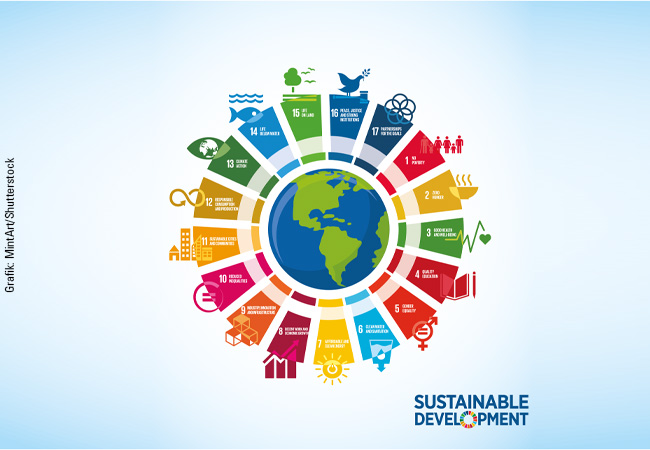Environmental students from countries with lower prosperity indicators rate the 17 Sustainable Development Goals of the United Nations as more important than environmental students from countries with higher prosperity indicators do. Moreover, they mostly assign the goals to only one pillar of sustainability, either social, economic or environmental sustainability. This is the conclusion drawn by a study by Goethe University Frankfurt, which is based on an online survey in 41 countries. Now, for the first time, findings are available about how a certain group of potential future decision-makers currently perceives the 17 goals. From this, specific recommendations can be derived for university education.

In 2015, the member states of the United Nations adopted the 2030 Agenda for Sustainable Development. The central element is the 17 Sustainable Development Goals (SDGs). These include “Zero Hunger”, “Clean Water”, “Responsible Consumption” and “Life Below Water”. The SDGs relate to all three pillars of sustainability, i.e. social, economic and environmental sustainability. Achieving the goals should enable a life of dignity for everyone worldwide and conserve the planet’s natural resources on a sustained basis. Yet how are the SDGs perceived in the first place, and what conclusions can be drawn from this? Until now, there has been a research gap in this area. The few international studies to date had mostly interviewed rather broad population groups. There was a lack of data that could deliver specific recommendations in certain realms of society, for example, how university practice could be improved in line with the 2030 Agenda.
A new study by Goethe University Frankfurt is now closing this research gap. It is based on an online survey in 41 countries in North America, South America, Africa, Asia, Oceania and Europe, which was conducted between September 2020 and July 2021. All 4,305 interviewees were exclusively students of environment-related subjects, such as environmental science, biology or nature management. They indicated on a scale of 1 to 5 how important they considered each individual SDG. “Our study is the first to document and evaluate how the UN’s Sustainable Development Goals are perceived among such a highly selected group of future decision-makers,” says first author Dr Matthias Kleespies from the Department of Didactics in the Biological Sciences and Zoo Biology at Goethe University Frankfurt.
The data show, says Kleespies, that the SDGs have a high level of acceptance among environmental students worldwide, irrespective of the region. For Kleespies, this is a pleasing result: “The major social, economic and environmental problems we’re currently facing worldwide are also perceived as such.”
Through factor analysis, a common statistical method, Kleespies was able to establish something else: the interviewees mainly assigned individual SDGs to only one of the three pillars of sustainability: for example, the goal “No Poverty” exclusively to the first pillar (social) or the goal “Climate Action” exclusively to the third pillar (environmental). These assignments led to a further result, says Kleespies: “We could see significant differences between countries in how they rate the three pillars.” For example, interviewees from Germany considered the environmental pillar to be particularly important, while interviewees from Thailand rated all three pillars as more or less equally important.
To be able to evaluate the differences between countries even more accurately, a further statistical analysis followed: the results from the individual countries were compared with five prosperity indicators, including the Human Development Index (HDI) and the Environmental Performance Index (EPI). A similar picture emerged for all five indicators. In a direct comparison, countries with lower indices – such as the Philippines – rated the SDGs as more important than countries with higher indices did, such as Canada. “This result surprised us, as older studies often showed that especially people in modern industrialised societies campaign more for environmental protection,” says Kleespies.
Even if the study is not transferable to a country’s entire population, it does, according to Professor Paul Dierkes, head of the Department of Didactics in the Biological Sciences and Zoo Biology, deliver important new insights. “To be able to put the SDGs into practice in a country, there needs to be great acceptance not only among the population but also among the people at the social and political interfaces. As potential future decision-makers and multipliers, students in the environmental domain are particularly important in this context. Although a university education in this field is no guarantee of a decision-making position, universities teach important skills, abilities and knowledge that qualify for such positions.”
What improvement measures for university education can be derived from the study? Kleespies says: “Degree programmes in the environmental sciences ought to address in greater depth the fact that the SDGs are multidimensional and that each of the goals contains a social, environmental and economic component.” After all, he says, the study has shown that students mostly overlook this multidimensionality. For example, SDG 15 – “Life On Land” – was often categorised as a solely environmental goal. “But protecting terrestrial ecosystems also includes very important economic and social components.” A second suggestion is directed specifically at more affluent countries, where the SDGs were rated as less important by comparison. Kleespies calls on the universities there to incorporate educational measures on the UN’s Sustainable Development Goals into the present curriculum of degree programmes: “In this way, students will be better informed than they are at the moment about the benefits and multidimensional nature of the SDGs.”
Over 4,000 students took part in the online survey and emails were sent to institutes in more than 50 countries. For 41 countries, the datasets were ultimately sufficient for a statistical analysis.
Publication: “The importance of the Sustainable Development Goals to students of environmental and sustainability studies – a global survey in 41 countries”, Matthias Winfried Kleespies & Paul Wilhelm Dierkes; https://doi.org/10.1057/s41599-022-01242-0









